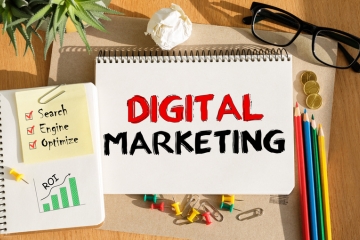
When it comes to graphic design, many people immediately think of Adobe Photoshop as the go-to software for creating stunning visuals. While Photoshop is undoubtedly a powerful tool, it's just the tip of the iceberg in the world of graphic design. Enrolling in a graphic design course not only hones your artistic skills but also introduces you to a wide range of tools and software that can take your creativity to new heights. In this article, we'll explore the various tools and software beyond Photoshop that you can expect to discover and master during a graphic design course.
Adobe Illustrator:
One of the most popular software applications among graphic designers is Adobe Illustrator. Unlike Photoshop, which is primarily used for editing and manipulating raster-based images, Illustrator focuses on vector-based graphics. It allows designers to create scalable illustrations, logos, typography, and complex shapes. Through a graphic design course, you'll learn how to utilize Illustrator's powerful tools, such as the pen tool, shape builder, and pathfinder, to bring your ideas to life with precision and flexibility.
Adobe InDesign:
For layout and print design, Adobe InDesign is an essential tool. InDesign enables designers to create multi-page documents, such as brochures, magazines, and books, with seamless integration of text and images. By enrolling in a graphic design course, you'll gain hands-on experience in utilizing InDesign's layout features, master typography controls, and understand how to create professional print-ready documents.
Adobe XD:
With the rise of user experience (UX) and user interface (UI) design, Adobe XD has become a staple tool in the graphic design industry. XD allows designers to create interactive prototypes and wireframes for websites and mobile applications. Through a graphic design course, you'll learn how to design seamless user experiences, create interactive elements, and test your designs for usability, ensuring that your digital creations are both visually appealing and user-friendly.
CorelDRAW:
While Adobe dominates the graphic design software market, CorelDRAW offers a strong alternative. CorelDRAW provides powerful vector graphics and illustration capabilities, similar to Adobe Illustrator, and is especially popular among designers in certain industries such as sign making, engraving, and textile design. A comprehensive graphic design course may introduce you to CorelDRAW, expanding your skillset and giving you the flexibility to work with different software options.
Sketch:
Favored by many UI and web designers, Sketch is a vector-based design tool that focuses on creating interfaces and digital products. It offers an intuitive and streamlined workflow specifically tailored to digital design. Through a graphic design course, you'll learn how to use Sketch to create pixel-perfect designs, collaborate with team members, and export assets for development.
Procreate:
For those interested in digital illustration and drawing, Procreate is a popular software choice. Available on iPad, Procreate offers a wide range of brushes and tools that simulate traditional art mediums. A graphic design course may introduce you to Procreate, helping you explore digital drawing techniques, develop your illustration skills, and discover new ways to create expressive and artistic designs.
3D Modeling and Rendering Software:
Graphic design courses often touch upon 3D modeling and rendering, introducing software like Autodesk 3ds Max, Blender, or Cinema 4D. These tools enable designers to create three-dimensional objects, environments, and animations. Understanding 3D design principles and techniques can open up opportunities in various industries, including product design, architecture, and visual effects.
Online Design Platforms:
In addition to traditional design software, graphic design courses may also introduce you to online design platforms such as Canva, Figma, or Adobe Spark. These platforms offer user-friendly interfaces and pre-designed templates, making it easier for beginners to create professional-looking designs quickly. Exploring these platforms can be beneficial for individuals interested in creating social media graphics, presentations, or other visual content.
Conclusion:
While Adobe Photoshop remains a powerful tool for graphic design, enrolling in a graphic design course provides you with the opportunity to explore a vast array of tools and software beyond Photoshop. From vector-based graphics in Adobe Illustrator to layout design in Adobe InDesign, and from interactive prototyping in Adobe XD to digital illustration in Procreate, these tools expand your creative possibilities and equip you with a diverse skillset. Embracing a wide range of software ensures that you are well-prepared to tackle a variety of design projects and opens up doors to different career paths in the ever-evolving field of graphic design.

He Laughed at My Computer Skills—Now He Asks Me for Help!

Warning: Skipping These PHP Tricks Might RUIN Your Web Development Career!

Instagram Likes Won’t Pay Your Bills—But This Digital Skills Will!

Your Brain Is Screaming for an Upgrade—Are You Ready for It?

From Beginner to Expert: How Basic Computer Skills Can Open New Opportunities

I Was Lost in My Career Until I Found Digital Marketing- Here's How it Transformed Me

Breaking the Middle-Class Mindset: Yes, Graphic Design Can Be a High-Paying Career

Breaking the ‘Non-IT Background’ Barrier: How Anyone Can Become a Developer with the Right Guidance

Graphic Design for Real-World Impact: Learn How to Build Apps, Brands, and Your Dream Career

Code Your Way to Confidence: How Programming Courses in West Bengal Are Giving Youngsters a Sense of Purpose

From Villages to Cities: How Basic Computer Courses Are Uniting and Empowering West Bengal

Break the 9-to-5 Cycle: Learn Digital Marketing and Create Your Own Path to Success in West Bengal